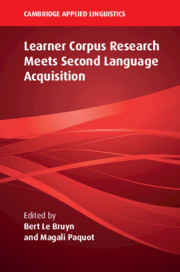Book contents
- Learner Corpus Research Meets Second Language Acquisition
- The Cambridge Applied Linguistics Series
- Learner Corpus Research Meets Second Language Acquisition
- Copyright page
- Contents
- Figures
- Tables
- Contributors
- Series Editors’ Preface
- Learner Corpus Research and Second Language Acquisition: an attempt at bridging the gap
- Article Use in Russian and Spanish Learner Writing at CEFR B1 and B2 Levels: Effects of Proficiency, Native Language, and Specificity
- L1 Influence vs. Universal Mechanisms: An SLA-Driven Corpus Study on Temporal Expression
- The Interplay between Universal Processes and Cross-Linguistic Influence in the Light of Learner Corpus Data: Examining Shared Features of Non-native Englishes
- Exploring Multi-Word Combinations as Measures of Linguistic Accuracy in Second Language Writing
- Using Syntactic Co-occurrences to Trace Phraseological Complexity Development in Learner Writing: Verb + Object Structures in LONGDALE
- Understanding the Long-Term Evolution of L2 Lexical Diversity: The Contribution of a Longitudinal Learner Corpus
- L2 Developmental Measures from a Dynamic Perspective
- Exploring Individual Variation in Learner Corpus Research: Methodological Suggestions
- Building an Oral and Written Learner Corpus of a School Programme: Methodological Issues
- Commentary: Have Learner Corpus Research and Second Language Acquisition Finally Met?
- Commentary: An SLA Perspective on Learner Corpus Research
- Index
- References
Commentary: Have Learner Corpus Research and Second Language Acquisition Finally Met?
Published online by Cambridge University Press: 29 December 2020
- Learner Corpus Research Meets Second Language Acquisition
- The Cambridge Applied Linguistics Series
- Learner Corpus Research Meets Second Language Acquisition
- Copyright page
- Contents
- Figures
- Tables
- Contributors
- Series Editors’ Preface
- Learner Corpus Research and Second Language Acquisition: an attempt at bridging the gap
- Article Use in Russian and Spanish Learner Writing at CEFR B1 and B2 Levels: Effects of Proficiency, Native Language, and Specificity
- L1 Influence vs. Universal Mechanisms: An SLA-Driven Corpus Study on Temporal Expression
- The Interplay between Universal Processes and Cross-Linguistic Influence in the Light of Learner Corpus Data: Examining Shared Features of Non-native Englishes
- Exploring Multi-Word Combinations as Measures of Linguistic Accuracy in Second Language Writing
- Using Syntactic Co-occurrences to Trace Phraseological Complexity Development in Learner Writing: Verb + Object Structures in LONGDALE
- Understanding the Long-Term Evolution of L2 Lexical Diversity: The Contribution of a Longitudinal Learner Corpus
- L2 Developmental Measures from a Dynamic Perspective
- Exploring Individual Variation in Learner Corpus Research: Methodological Suggestions
- Building an Oral and Written Learner Corpus of a School Programme: Methodological Issues
- Commentary: Have Learner Corpus Research and Second Language Acquisition Finally Met?
- Commentary: An SLA Perspective on Learner Corpus Research
- Index
- References
Summary
Although learner corpus research (LCR) and second language acquisition (SLA) studies both partake of the general field of L2 studies, it must be acknowledged that they are still essentially two different worlds. The distance between the two fields was noted as early as 1999 by Hilde Hasselgård in her review of the first volume on LCR (Granger 1998): ‘A question that remains unanswered is whether corpus linguistics and SLA have really met in learner corpus research. While learner language corpus research does not seem to be very controversial in relation to traditional corpus linguistics, some potential conflicts are not resolved, nor commented on by anyone from “the other side”’ (Hasselgård 1999, 152). This echoed Geoffrey Leech’s rather bleak observation in his preface to the volume: ‘If … we characterise the theme of this book as ‘SLA meets corpus linguistics’, this is not likely to be a meeting of unalloyed joy and good will. Rather, it may well be an encounter marked by some suspicion and misunderstanding’ (Leech 1998, xvi).
- Type
- Chapter
- Information
- Learner Corpus Research Meets Second Language Acquisition , pp. 243 - 257Publisher: Cambridge University PressPrint publication year: 2021

